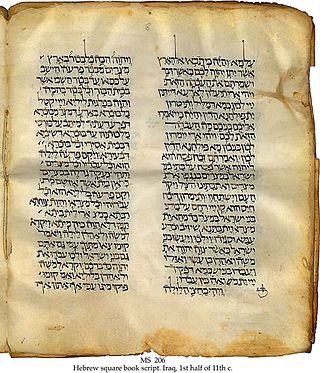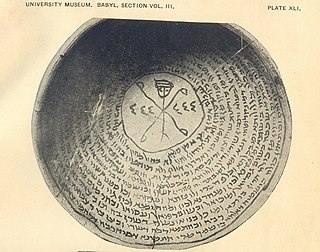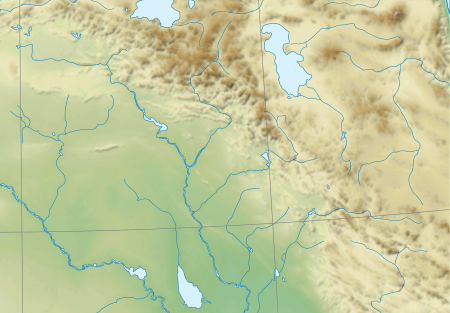Aramaic is a Northwest Semitic language that originated among the Arameans in the ancient region of Syria, and quickly spread to Mesopotamia and eastern Anatolia where it has been continually written and spoken, in different varieties, for over three thousand years. Aramaic served as a language of public life and administration of ancient kingdoms and empires, and also as a language of divine worship and religious study. Several modern varieties, namely the Neo-Aramaic languages, are still spoken.

A targum was an originally spoken translation of the Hebrew Bible that a professional translator would give in the common language of the listeners when that was not Hebrew. This had become necessary near the end of the first century BC, as the common language was Aramaic and Hebrew was used for little more than schooling and worship. The translator frequently expanded his translation with paraphrases, explanations and examples, so it became a kind of sermon.

Jewish languages are the various languages and dialects that developed in Jewish communities in the diaspora. The original Jewish language is Hebrew, supplanted as the primary vernacular by Aramaic following the Babylonian exile. Jewish languages feature a syncretism of indigenous Hebrew and Judeo-Aramaic with the languages of the local non-Jewish population.

Judeo-Arabic dialects are ethnolects formerly spoken by Jews throughout the Arabic-speaking world. Under the ISO 639 international standard for language codes, Judeo-Arabic is classified as a macrolanguage under the code jrb, encompassing four languages: Judeo-Moroccan Arabic (aju), Judeo-Yemeni Arabic (jye), Judeo-Iraqi Arabic (yhd), and Judeo-Tripolitanian Arabic (yud).
Judeo-Italian is an endangered Jewish language, with only about 200 speakers in Italy and 250 total speakers today. The language is one of the Italian languages. Some words have Italian prefixes and suffixes added to Hebrew words as well as Aramaic roots.

Biblical Aramaic is the form of Aramaic that is used in the books of Daniel and Ezra in the Hebrew Bible. It should not be confused with the Targums – Aramaic paraphrases, explanations and expansions of the Hebrew scriptures.
The Jewish Neo-Aramaic dialect of Urmia, a dialect of Northeastern Neo-Aramaic, was originally spoken by Jews in Urmia and surrounding areas of Iranian Azerbaijan from Salmas to Solduz and into what is now Yüksekova, Hakkâri and Başkale, Van Province in eastern Turkey. Most speakers now live in Israel.
Trans-Zab Jewish Neo-Aramaic, also known as Hulaulá, is a grouping of related dialects of Northeastern Neo-Aramaic originally spoken by Jews in Iranian Kurdistan and easternmost Iraqi Kurdistan. Most speakers now live in Israel.
Barzani Jewish Neo-Aramaic is a modern Jewish Aramaic language, often called Neo-Aramaic or Judeo-Aramaic. It was originally spoken in three villages near Aqrah in Iraqi Kurdistan. The native name of the language is Lishanid Janan, which means 'our language', and is similar to names used by other Jewish Neo-Aramaic dialects .

Judaeo-Aramaic languages represent a group of Hebrew-influenced Aramaic and Neo-Aramaic languages.

Judeo-Tat or Juhuri is the traditional language of the Mountain Jews of the eastern Caucasus Mountains, especially Azerbaijan and Dagestan, now mainly spoken in Israel.
Northeastern Neo-Aramaic (NENA) is a grouping of related dialects of Neo-Aramaic spoken before World War I as a vernacular language by Jews and Christians between the Tigris and Lake Urmia, stretching north to Lake Van and southwards to Mosul and Kirkuk. As a result of the Sayfo Christian speakers were forced out of the area that is now Turkey and in the early 1950s most Jewish speakers moved to Israel. The Kurdish-Turkish conflict resulted in further dislocations of speaker populations. As of the 1990s, the NENA group had an estimated number of fluent speakers among the Assyrians just below 500,000, spread throughout the Middle East and the Assyrian diaspora. In 2007, linguist Geoffrey Khan wrote that many dialects were nearing extinction with fluent speakers difficult to find.
Samaritan Aramaic, or Samaritan, was the dialect of Aramaic used by the Samaritans in their sacred and scholarly literature. This should not be confused with the Samaritan Hebrew language of the Scriptures. Samaritan Aramaic ceased to be a spoken language some time between the 10th and the 12th centuries, with Samaritans switching to Palestinian Arabic as their vernacular language.
Baghdad Jewish Arabic or autonymhaki mal yihud or el-haki malna is the Arabic dialect spoken by the Jews of Baghdad and other towns of Southern Iraq. This dialect differs from the dialect spoken by the Jews in Northern Iraq, such as Mosul and 'Ana. The Baghdadi and Northern dialects may be regarded as subvarieties of Judeo-Iraqi Arabic. As with most Judeo-Arab communities, there are likely to be few, if any, speakers of the Judeo-Iraqi Arabic dialects who still reside within Iraq. Rather these dialects have been maintained or are facing critical endangerment within respective Judeo-Iraqi diasporas, namely those of Israel and the United States. In 2014, the film Farewell Baghdad, which is performed mostly in Jewish Baghdadi Arabic dialect, became the first film to be almost completely performed in Judeo-Iraqi Arabic.

Jewish Babylonian Aramaic was the form of Middle Aramaic employed by writers in Lower Mesopotamia between the fourth and eleventh centuries. It is most commonly identified with the language of the Babylonian Talmud and of post-Talmudic (Gaonic) literature, which are the most important cultural products of Babylonian Jews. The most important epigraphic sources for the dialect are the hundreds of inscriptions on incantation bowls.
Old Aramaic refers to the earliest stage of the Aramaic language, known from the Aramaic inscriptions discovered since the 19th century.

Judaeo-Spanish or Judeo-Spanish, also known as Ladino, is a Romance language derived from Old Spanish. Originally spoken in Spain, and then after the Edict of Expulsion spreading through the Ottoman Empire as well as France, Italy, the Netherlands, Morocco, and England, it is today spoken mainly by Sephardic minorities in more than 30 countries, with most speakers residing in Israel. Although it has no official status in any country, it has been acknowledged as a minority language in Bosnia and Herzegovina, Israel, France, and Turkey. In 2017, it was formally recognised by the Royal Spanish Academy.
Betanure Jewish Neo-Aramaic, the local language variety of Betanure in Iraqi Kurdistan, is among the rarest and most seriously endangered varieties of Aramaic spoken at the present time. It is also one of the most conservative of both Jewish Neo-Aramaic languages and the Northeastern Neo-Aramaic languages in particular.

The Judeo-Iranian languages are a number of related Jewish variants of Iranian languages spoken throughout the formerly extensive realm of the Persian Empire. Judeo-Iranian dialects are generally conservative in comparison with those of their Muslim neighbours. Judeo-Shirazi, for example, remains close to the language of Hafez.








